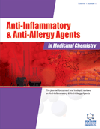- Home
- A-Z Publications
- Anti-Inflammatory & Anti-Allergy Agents in Medicinal Chemistry (Formerly Current Medicinal Chemistry - Anti-Inflammatory and Anti-Allergy Agents)
- Previous Issues
- Volume 8, Issue 2, 2009
Anti-Inflammatory & Anti-Allergy Agents in Medicinal Chemistry (Formerly Current Medicinal Chemistry - Anti-Inflammatory and Anti-Allergy Agents) - Volume 8, Issue 2, 2009
Volume 8, Issue 2, 2009
-
-
Editorial [Hot topic: Antiretroviral, Anti-Inflammatory and Dopaminergic Substances in the Treatment of HIV-Infection (Guest Editor: Gabriele Arendt)]
More LessWelcome to the 2009 Anti-Inflammatory & Anti-Allergy Agents in Medicinal Chemistry (HOT TOPIC) Vol. 8, June 2009. The topic we have chosen for this volume is the treatment of HIV-infection, antiretroviral as well as anti-inflammatory and dopaminergic. We highlight the current therapeutic state-of-the-art as well as future therapeutic options. In particular, Arendt and Nolting analyse the current knowledge on the role of inter Read More
-
-
-
Cytokines in HIV-Infection - Inflammatory Damage or Therapeutic Potential?
More LessAuthors: Gabriele Arendt and Thorsten NoltingIntroduction: HIV-1 is regarded most responsible for a neurodegenerative disease, called HIV-associated dementia (HAD). The pathogenic trait of this severe complication of HIV-infection is still unclear, but disturbed systemic and central nervous system immune function seem to be an important component. Cytokines are important mediators of the human immune system. The review focusses on major cytokines and r Read More
-
-
-
Complement and Microglia in the Neuropathogenesis of HIV Infection: Pro- and Anti-Inflammatory Aspects
More LessAuthors: Cornelia Speth, Gunter Rambach and Sieghart SopperViral penetration into the central nervous system (CNS) is an early event in the course of human immunodeficiency virus (HIV) pathogenesis and occurs in the vast majority of the infected individuals. Consequences are diverse symptoms of neurological dysfunction in a substantial proportion of patients, as well as the establishment of a lifelong viral reservoir. The severity of symptoms ranges from subclinical alterations in mot Read More
-
-
-
Neurotransmitter Effects in Human Immunodeficiency Virus (HIV) and Simian Immuno-Deficiency Virus (SIV) Infection
More LessGlutamate-mediated neurodysfunction plays a crucial role in the pathogenesis of human immunodeficiency virus (HIV) and simian immunodeficiency virus (SIV) encephalitis. The regulation of glutamatergic neurotransmission in inflammation is a complex interaction between activation of immune mediators and adaptive changes in the functional elements of the glutamatergic synapse. Our studies in simian im Read More
-
-
-
Pharmacogenomics - Implications in the Development of HIV-Associated Brain Disease
More LessAuthors: Thorsten Nolting and Gabriele ArendtPharmacogenomics is a relatively new field in HIV-research, especially when neurological issues are concerned. Influence of polymorphisms in CYP3A4, CYP2B6, CYP2D6, ABCB1, ABCG2, ABCC4, SLC22, SLC28, SLC29 and MMP9-genes on pharmacokinetic data is discussed in the article. Due to the lack of published studies, but promising results in the few existing publications, scientists should be encouraged to integrate neuro Read More
-
-
-
Penetration and Effectiveness of Antiretroviral Therapy in the Central Nervous System
More LessCombination antiretroviral therapy (ART) has markedly reduced morbidity and mortality among HIV-infected individuals but not the prevalence of HIV-associated neurocognitive disorders (HAND). Several conditions may be responsible for the high prevalence of cognitive impairment, including incomplete suppression of HIV in nervous system by some antiretrovirals. Since individuals with HAND have a lower quality of life, worse Read More
-
-
-
Methamphetamine and HIV Infection, Role in Neurocognitive Dysfunction
More LessAuthors: Katherine Conant, Arun Venkatesan and Avindra NathThe use of methamphetamine is steadily increasing worldwide. Its use is associated with high-risk sexual behavior and subsequent infection with HIV. Methamphetamine has profound effects on the brain both as an acute intoxicant and following chronic exposure. The combined effects of HIV and methamphetamine appear to result in widespread neuronal and white matter injury. These changes are most prominent in the basa Read More
-
-
-
Neurotoxicity and Side-Effects of Highly Active Antiretroviral Therapy [HAART] on the Central and Peripheral Nerve System
More LessAuthors: I. W. Husstedt, D. Reichelt, E. Neuen-Jakob, F. Kastner, R. v. Einsiedel, B. Vielhaber, G. Arendt, S. Evers and K. HahnHighly active antiretroviral therapy [HAART] has increased the mean survival time in the AIDS stage by up to more than 10 years. Five different groups of antiretroviral medications are known, of which integrase and entry inhibitors represent the latest and most modern substances. The long survival time in the AIDS stage means that side effects and interactions become of greater relevance and have to be differentiated from Read More
-
Volumes & issues
-
Volume 24 (2025)
-
Volume 23 (2024)
-
Volume 22 (2023)
-
Volume 21 (2022)
-
Volume 20 (2021)
-
Volume 19 (2020)
-
Volume 18 (2019)
-
Volume 17 (2018)
-
Volume 16 (2017)
-
Volume 15 (2016)
-
Volume 14 (2015)
-
Volume 13 (2014)
-
Volume 12 (2013)
-
Volume 11 (2012)
-
Volume 10 (2011)
-
Volume 9 (2010)
-
Volume 8 (2009)
-
Volume 7 (2008)
-
Volume 6 (2007)
-
Volume 5 (2006)
Most Read This Month
Article
content/journals/aiaamc
Journal
10
5
false
en


